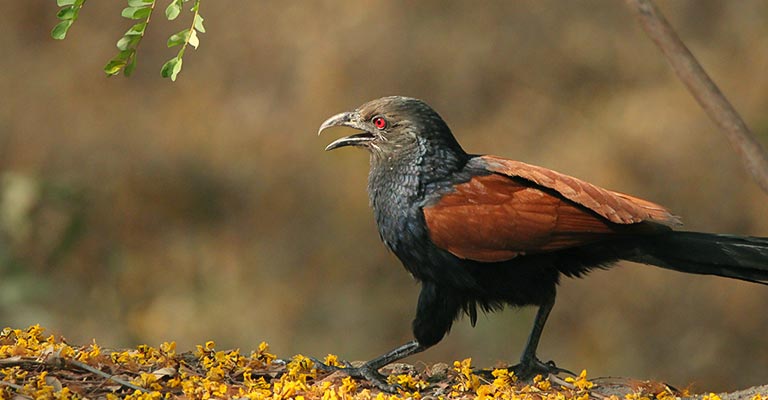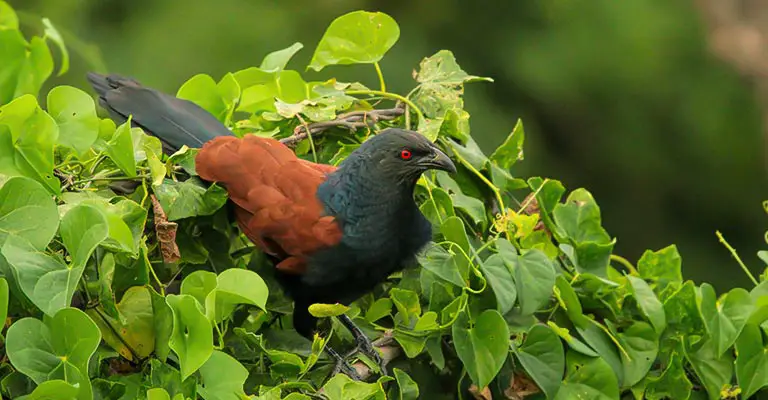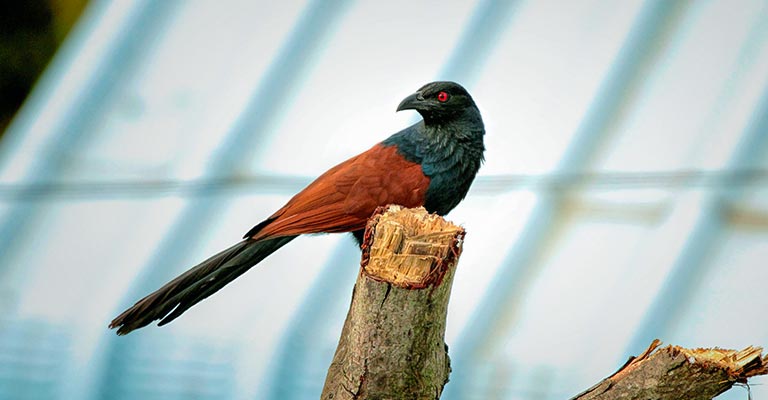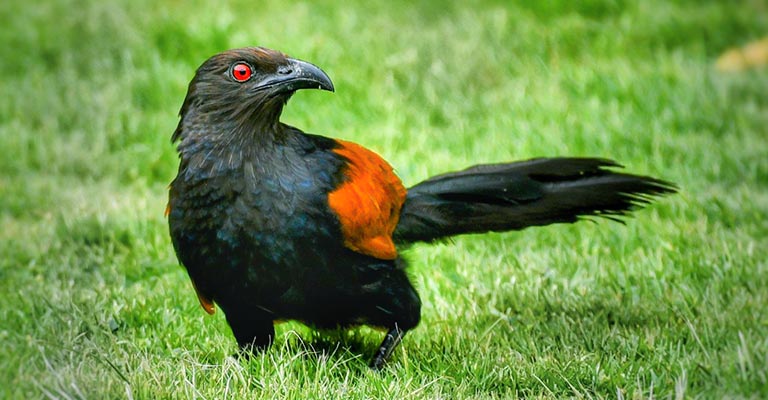Ever stumbled upon a large, black bird with striking red eyes and thought, “What’s that?” Chances are, you’ve spotted a Greater Coucal. It’s a bird as intriguing as it is beautiful, and there’s plenty to learn about.
The Greater Coucal, a member of the cuckoo order of birds, is a sight to behold. It’s found across South and Southeast Asia, making it home in various habitats. Despite its widespread presence, a certain mystique surrounds this bird.
Diving into the world of the Greater Coucal is like embarking on a fascinating journey. From its unique calls to its distinctive appearance, each aspect of the Greater Coucal tells a story worth exploring. Let’s take a closer look at this magnificent creature.
Characteristics of the Greater Coucal

The Greater Coucal, known for its distinctive presence, offers a blend of remarkable traits that set it apart. Its appearance is quite unusual, mixing splashes of bright and bold colors with dark shades.
The Greater Coucal exhibits a head-to-tail length of about 48 cm, making it a relatively large member of the cuckoo order. A deep maroon tail and lower belly complement its long, glossy black wings and bodice.
The striking factor that instantly grabs our attention is the luminous red eyes with a striking yellow eyelid, a mysterious glaze that intrigues bird watchers and nature enthusiasts alike.
One of the standout qualities of the Greater Coucal is its unique call. I’ve found the sound a low, resonant ‘coop-coop-cop.’ It’s almost uncanny how the slow, rhythmic hooting resounds in the early morning, adding a touch of liveliness to the dawn.
Traits associated with Greater Coucal:
- Size: 48cm from head to tail
- Color: Black body with maroon tail
- Eye color: Luminous red with yellow eyelid
- Call: Low resonance ‘coop-coop-co’
The world of Greater Coucal isn’t just limited to its fascinating appearance. Another noteworthy aspect of the bird revolves around its nesting habits.
Unlike many members of the cuckoo family that are brood parasites, the Greater Coucal lays its eggs in its nests, an exception to the cuckoo family norm.
True elegance lies in simplicity. Even while the Greater Coucal refrains from the extravagant displays often associated with birds, it imbues the scenery with an enchanting presence.
Every glimpse of this magnificent creature brings a newfound respect for Mother Nature’s exquisiteness.
While diving deeper into the life of the Greater Coucal, there are always more captivating aspects to unfold. So, for all bird lovers and wildlife enthusiasts, this mysterious member of the cuckoo family serves as a striking reminder: nature never fails to surprise.
Distribution and Habitat

We may encounter the Greater Coucal when we wander deep into forests or explore tranquil countryside areas. A creature that thrives in various settings, it’s found across a vast Southeast Asian region, from Pakistan to Indonesia.
As an elusive bird with a knack for adapting to different locales, the Greater Coucal isn’t picky about its living quarters. It’s home in scrubs, forests, thickets, and even cultivated lands.
So whether it’s a rainy forest in the Western Ghats, a mangrove swampland in Sundarbans, or the wooded patches in Bali, the bird carves its niche in every setting. This uncanny adaptability marks out the Greater Coucal, underlining its innate survival skills.
Yet, don’t mistake its choice of diverse habitats as a sign of its population boom. Despite its broad reach, the Greater Coucal’s existence sits on the balance.
The International Union for Conservation of Nature (IUCN) categorizes the Greater Coucal as a species of ‘Least Concern.’ Still, it flags the steady loss of its habitat as a continual issue. From deforestation to global warming, a myriad of factors pose threats to the Greater Coucal.
Exploring its distribution and habitats, we see that the bird’s adaptability is both a strength and a weakness in the face of urbanization and climatic changes.
Further research into this bird aids our understanding and contributes to conservation efforts, securing a future for the Greater Coucal.
But let’s not forget, it’s not just about securing its future, preserving the habitats has broader implications. A bird doesn’t just live in its environment; it’s a vital part.
From the heart of a dense Indonesian jungle to the serene backwaters of Kerala, the Greater Coucal has painted its hues and lent its voice. It’s been coloring landscapes with its undeniable charm, warming up sunny days with its swoops, and lulling sleepy dusks with its resonant cries.
Let’s look further into the Greater Coucal’s life, revealing its unique mannerisms and intriguing lore.
| Region | Habitat |
|---|---|
| Pakistan | Forests, Scrubs |
| Western Ghats | Rainy Forests |
| Sundarbans | Mangrove Swamplands |
| Bali | Wooded Patches |
Behavior and Feeding Habits of the Greater Coucal

The behavior and feeding habits of the Greater Coucal shed light on its remarkable adaptability and ecological significance within its environment.
Unlike many avian species, the Greater Coucal is predominantly terrestrial, preferring to forage on the ground rather than relying on flight for sustenance.
Dietary Adaptations
The Greater Coucal’s omnivorous diet reflects its ability to thrive in diverse habitats. It preys on various organisms, including insects, snails, lizards, small snakes, and rodents, while consuming plant matter such as fruits and seeds.
This broad dietary spectrum underscores its role as a predator and seed disperser, contributing to ecosystem health and biodiversity.
Foraging Behavior
Foraging primarily alone or in pairs, the Greater Coucal employs persistent probing with its long, robust bill to uncover prey from the ground or vegetation.
Despite its relative weakness in flight, it compensates with adept climbing skills, enabling it to access elevated food sources such as fruits and berries in trees and bushes.
Breeding Behavior
During the breeding season, typically between February and September, the Greater Coucal constructs nests concealed within dense vegetation to protect its clutch of up to three eggs from predators.
This strategic nesting behavior ensures its offspring’s survival and contributes to its population maintenance.
Reproduction and Nesting of the Greater Coucal

The Greater Coucal’s reproductive process offers a fascinating glimpse into its natural behaviors and social dynamics. As monogamous birds, Greater Coucals form lifelong partnerships, displaying remarkable loyalty to their chosen mate.
Breeding Season and Mating
The breeding season typically occurs between April and September, during which mating pairs engage in courtship rituals and mate to initiate the reproductive process. This synchronization ensures optimal timing for breeding and raising offspring.
Nesting Behavior
Nesting is a meticulous process for Greater Coucals, involving the construction of deep cup-shaped nests using twigs, leaves, and grass.
These nests are strategically placed in dense vegetation or low bushes, reflecting the bird’s preference for ground-based habitats. The female lays a clutch of about 2-5 pale white eggs within the nest once it is completed.
Shared Parenting
A notable aspect of Greater Coucal nesting is the division of responsibilities between male and female partners. Both parents take turns incubating the eggs, lasting approximately 15-20 days until hatching.
Following hatching, both parents feed and care for the chicks until they fledge, typically around 3-4 weeks after hatching.
Adherence to Partnership and Teamwork
The Greater Coucal’s adherence to monogamy and shared parenting exemplifies its cooperative social structure and remarkable teamwork in the wild. These behaviors set it apart from many other bird species and highlight its capacity for cooperation and mutual support within the breeding pair,
Conservation Status
As we continue exploring the remarkable life of the Greater Coucal, it’s essential to assess its conservation status. Largely unexplored, Greater Coucal’s population trend is crucial in understanding its survival mechanism in the wild.
The International Union for Conservation of Nature (IUCN) offers an authoritative perspective on the species’ conservation status. Their most recent assessment classified the Greater Coucal as a species of most minor concern.
A table summarizing the findings from the report is below:
| Greater Coucal | |
|---|---|
| Conservation Status | Least Concern |
| Population Trend | Stable |
Moving on, it is essential to note that this status doesn’t mean the bird is free from threats. Habitat loss and human-induced landscape changes have a considerable impact on the species.
Yet, their adaptation skills have empowered them to withstand such challenges and maintain a stable population, which is quite impressive.
The Greater Coucal has been found in diverse habitats ranging from dense forests to cultivated regions. Their flexible diet, primarily consisting of insects, snails, and small vertebrates, allows them to live in various environments—another testament to their impressive survival skills.
However, as with any wildlife species, the Greater Coucal’s stability today doesn’t ensure its future. Ongoing conservation efforts are vital to preserve these birds and their habitat.
Conclusion
The Greater Coucal’s resilience and adaptability are critical to its survival. Despite facing threats like habitat loss, this bird species continues to thrive, thanks to its flexible diet and ability to adapt to various habitats.
Yet, we can’t overlook the importance of ongoing conservation efforts. Preserving the Greater Coucal and its habitat is paramount, not only for the species itself but also for maintaining ecological balance.
After all, every species has a role to play in the ecosystem. So, let’s not take the Greater Coucal’s ‘least concern’ status for granted. It’s our responsibility to ensure we’re safeguarding our biodiversity against the impacts of climate change.